The world of Slavic mythology is of the most mysterious and richest ancient and living traditions in the world. As Slavs are the largest ethno-linguistic group in Europe, their beliefs are widespread, diverse, and unique. However, they share a lot of similarities, all stemming from the same source, and all sharing the same core beliefs. And one animal that is a recurring figure in all these myths is the wolf. A powerful, totemic animal, the wolf always held a special place in the legends and myths of the Slavic peoples. And the wolf shepherd deity is one of the most enduring beliefs in the Slavic world. However, the arrival of Christianity sought to pervert and erase the wolf shepherd deity, often connecting the wolf with negative connotations. Nevertheless, bolstered with modern resources and years of research, we can now perfectly see the origins of the wolf shepherd deity in Slavic belief.
The Deep Roots Of Slavic Myths And Ethnology
When researching Slavic folklore , scholars often have a relatively easy job, thanks to the immense similarities between the modern Slavic languages . And these things are often exclusive for the oldest, most important terms and rituals. Even more significant is the power and extent of Slavic paganism and ancient traditions that have survived to this very day. Known to be very stubborn, the Slavs were the hardest people to convert to Christianity. That is why early missionaries and rulers took a unique approach to their conversion.
By preserving all the traditions, beliefs, dates, and myths of original Slavic paganism, and simply changing the names of gods, spirits, and demons into the names of Christian saints , both sides would be equally pleased. Of course, time did its work, and the old myths and beliefs became hazy, clouded, and the power of Christ took over. But the scholar’s eye is hard to fool: the truth is there, plain to see.
And in the research of these myths, the primary work is reserved for ethnologists. This is because the core of the matter remains perfectly preserved, as if frozen in time, amongst the ordinary folk, the inhabitants of far and remote villages in the Carpathians, the Balkan mountains all over the Slavic world. Travelling to these places, and hearing the legends as told by the elderly, one feels transported through time.
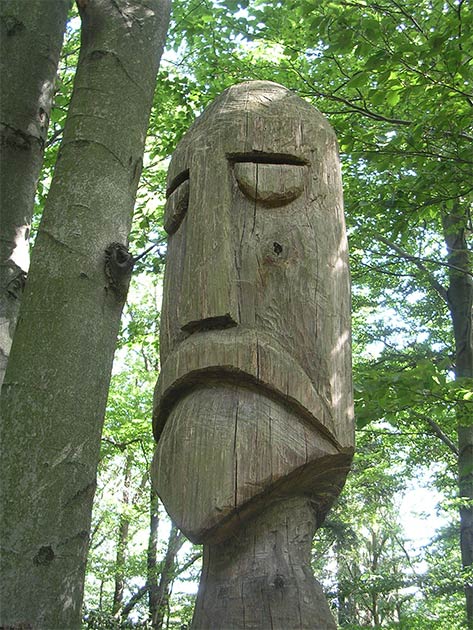
The Slavic pagan god Veles, who is connected with the rebirth of new souls and, thus, reincarnation. (cs:ŠJů / CC BY-SA 3.0 )
And in all these traditions, the wolf has a special place. For the ancient Slavs, animals enjoyed a much greater respect than they do today, and in many cases they were venerated. It was believed that some animals were an enigmatic link between the worlds of the living and the dead, day and night. They were seen as manifestations of human souls taking on an animal form. Such human souls were seen as special or chosen, since Slavs believed in a form of reincarnation. A human soul escaped into birds when someone died, and as the bird migrated to the south in winter, so did the soul go to roost in the world tree, which was guarded by the god Veles. These birds then returned in the summer and gave new souls to newborn children, thus completing the circle of reincarnation.
When a soul “migrated” into an animal, in this case a wolf, this was a sign of a godlike connection. Certain animals were sacred and clearly connected to individual deities. And the story of the lame wolf and the wolf shepherd deity , a recurring theme in all Slavic nations, points to the wolf’s connection with the highest deities of the Slavic pantheon.
As we research this mysterious connection between wolf and the world of the gods, we can start to understand the complex set of beliefs that the Slavs had. Because there is almost a distinct fear of the gods, fear and respect, and both of these traits are connected with the wolf as a wild animal.
The wolf is solitary, a hunter, cunning and stubborn, proud and fierce. A wild wolf can never be captured. Rather, he fights to the death. And the wolf is often synonymous with everything “foreign,” as an “outsider.” This is also connected with the idea of a flock or a herd, with the wolf infiltrating it to wreak havoc. And it is exactly this connection between the gods, the wolf, and the fear of the fierce predator, that described the image of the lame wolf, a widely known Slavic belief.
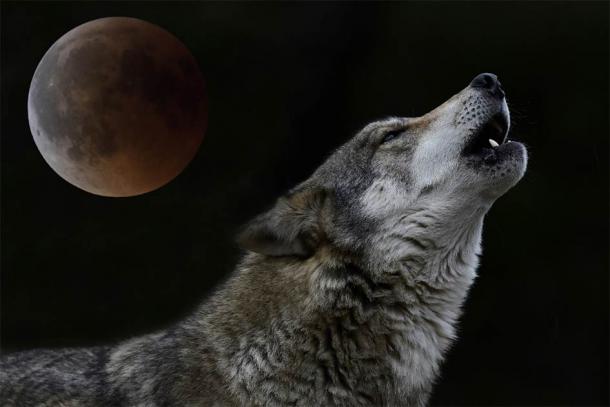
A wolf howling at full moon: wolves formed a key part of Slavic mythology and beliefs. These beliefs were then “hijacked” by Christianity and turned into something else. ( bennytrapp / Adobe Stock)
The Connecting Fiber of Universal Slavic Myths
As early as 1924, leading Slavic ethnologists recognized a pattern amongst all Slavic nations. This recurring theme included the devil depicted as lame and having the form of the wolf. It also included the idea of a wolf shepherd deity. It is highly probable that the connection between the lame wolf and the devil came from Christianity, as original Slavic deities were increasingly demonized and connected to the devil.
One of the leading ethnologists of the Slavic world, the Serbian scholar Veselin Čajkanović, contributed a lifetime of extensive Slavic folklore research. In 1924 he authored an extensive work proving that the ancient “wolf shepherd deity” of the Slavs was the same as the Christian figure of Saint Sava. From then on, similar traditions were documented in many other regions ranging from the Ukraine, Serbia, and Bulgaria to Russia and Poland.
The Lame Wolf in these Christian traditions was often symbolized as the devil. But for scholars it became clear that the lame wolf character is that of an ancient deity. Thus, we see that in many nations certain Christian saints are stylized as lame, or as shepherding wolves. In the Ukraine, for example, Saint Nicholas often appears as a lame shepherd of wolves. In remote Ukrainian villages there is a common saying: “ Mikolay (Nicholas) is lame, lightning will kill me!” In Bulgaria there is a surviving belief about Saint George , who is the Christian form of the Slavic god Yarilo. Ukrainian villagers believed that Saint George had to cut off a piece of his own heel to return from the “underworld to the world above,” giving him the aspect of lameness.
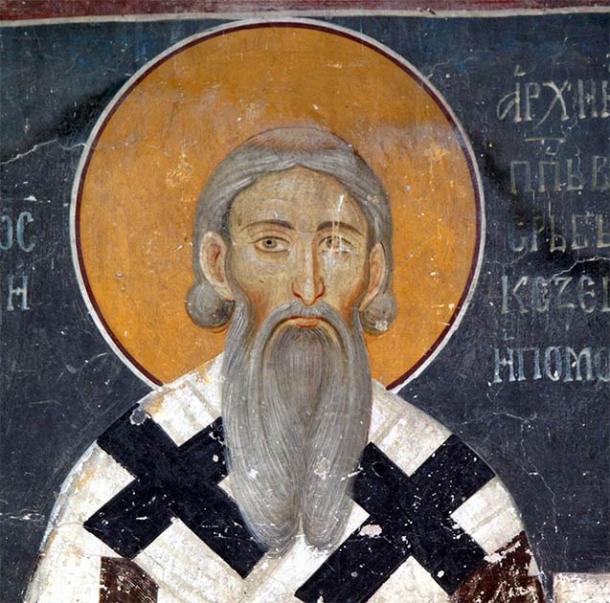
Saint Sava, the Slavic wolf shepherd deity, depicted in the Serbian tradition. ( Public domain )
Lutz Röhrich, a leading German folklorist, was one of the first researchers to fully recognize the connection between modern Christian saints and the pagan figure of the wolf shepherd deity. His work has been an invaluable source of information for all Slavic researchers.
Based on these insights, we can safely deduce that the figure of the “wolf shepherd deity” is almost certainly that of the Slavic god Veles. Veles is generally viewed as the deity of cattle, animals, and the underworld. He is also seen as the shepherd of souls guarding the great linden tree where the birds that carry the souls of the deceased roosted.
Today, Veles is often portrayed as shepherding animals, particularly bears or wolves. And, crucially, Veles was without a doubt extensively demonized in the Christianized Slavic world, being identified with the devil. Thus, in Macedonia, for example, the devil is oft called “one-legged,” or “lame.” And in the remote mountainous villages of southern Serbia various legends are attributed to Saint Sava. And it is said that “god” ordered Saint Sava to command the wolves.
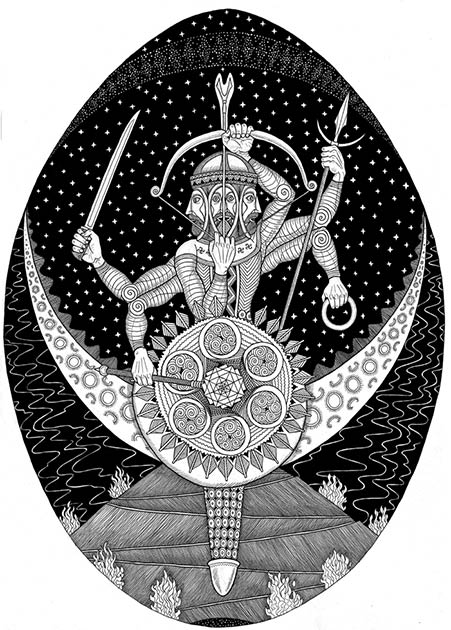
The sun-god Dabog: the Slavic blacksmith god and lord of the heavens. Dabog was the son of Svarog. (Mhapon / CC BY-SA 4.0 )
The Heritage Of Millennia: The Lame Smith-Gods
Another intriguing example of the wolf shepherd deity myth related to “Lame Daba,” a Christian demonization of the chief Slavic deity Dabog. Dabog, the giving god, was the patron of the sun, rain, and everything good. Often, particularly amongst southern Slavs, Dabog is connected to the underworld and the wolf shepherd deity role. However, after the arrival of Christianity in the Slavic lands, it seems that Dabog gradually became a symbol of the devil and was seen to be “lame.” This goes to show that lameness in pagan Slavic beliefs was much more widespread than previously known.
Lameness is one of the major attributes of many Indo-European deities. For example, the Greek deity Hephaestus, god of artisans, fire, blacksmithing, and metalworking is often compared with or likened to the Slavic God Svarog, the sky smith, and the father of Dabog. For Hephaestus, lameness was one of his chief attributes. In Greek, he was also known as Amphigýeis (Ἀμφιγύεις), meaning The Lame One, or with an epithet chōlos ( lame). Various legends are ascribed to his lameness. Vulcan, his Roman counterpart was likewise lame.
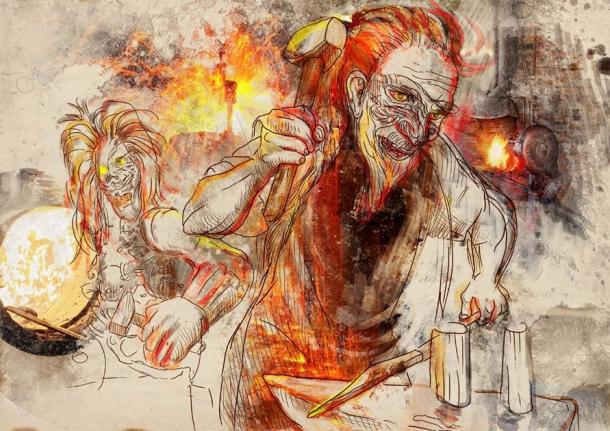
A drawing of Hephaestus “working” as a blacksmith. ( kuco / Adobe Stock)
In Germanic mythology, there is Wayland, the Legendary Smith, who is the focus of many legends. It is most likely that Wayland was a god amongst the Germanic peoples. And likewise, Wayland, the blacksmith of great skill was lame. This attribute, as well as other physical deformities, appear in many other smith gods and similar myths. Most of Indo-European smith gods were lame. But where does this lameness characteristic come from?
The secret lies in the forging process itself. Scholars attribute lameness to arsenicosis, which is the effect of arsenic exposure in high levels, to which ancient smiths were unavoidably exposed to. Arsenicosis leads to numerous issues, chief of these being lameness and skin cancer. It was prevalent in the Bronze Age, when smiths had to mix arsenic with copper to harden it, since tin was not easily available in some areas. And, as we know, arsenic is a highly toxic chemical. This proves that most Bronze Age smiths would have without a doubt suffered from chronic arsenic poisoning. And the image of the lame smith survived through time and transformed itself into the images of gods and heroes, long after the Bronze Age gave way to the Iron Age.
That these ancient myths survived several thousand years after the Bronze Age, shows us just how important and widespread they were in Europe. Metal smiths in ancient times were highly regarded, possessing “secret” knowledge, and sacrificing themselves in almost mythical ways. And for this reason, the Lame Shepherd of Wolves remains a belief that is both ancient and beyond logic. It has survived, struggling through time, to the present day, to this very moment. This goes to show that we are descended from truly unique cultures that were in tune with the world around them, and with the key aspects of life.
The legends of the wolf shepherd deity and the lame god are not just Slavic. However, it is most perfectly preserved, even in modern times, in the Slavic mythological tradition. In fact, many Slavic belief are the perfect source for studying even older, Pan-European traditions, some of which predate the arrival of the Indo-Europeans. And that goes to show us just how incredible the memory of cultures and societies can be. Myths and stories, tales and beliefs, travel from generation to generation, through wars and migrations. They survive for thousands of years and still live on in modern societies in the Slavic world.
Preserved Through Time
There is so much we can discover by listening to the old tales of our grandparents and to the endlessly intriguing elements of our own folklore traditions. It is often surprising to learn just how much of these beliefs survived through the ages, becoming an inseparable part of who we are today.
Slavs, Germanic peoples, Balts, Greeks, and all others share some defining stories, directly related to our origins. The stories of wolf shepherd deities and lame smith gods are just a part of this intricate web of traditions.
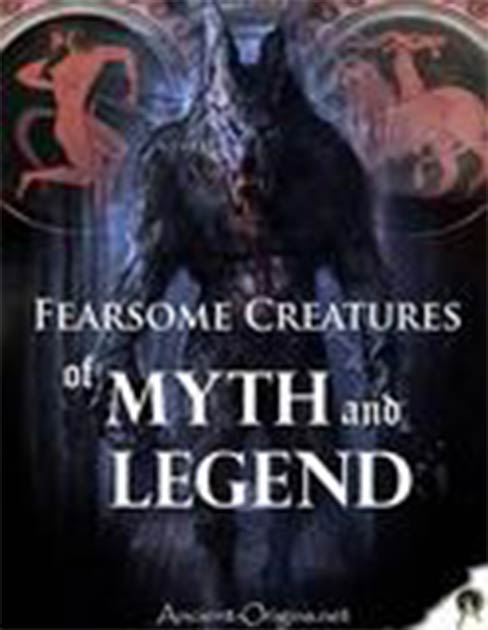 Explore the hidden histories and ancient myths associated with fearsome creatures and monstrous beasts, from the legendary hell hound of the underworld to the Mongolian death worm, the Bird-Women of Slavic mythology, the fierce mythical unicorn, the vicious Japanese water imp, and much more. This Ancient Origins Special is available here.
Explore the hidden histories and ancient myths associated with fearsome creatures and monstrous beasts, from the legendary hell hound of the underworld to the Mongolian death worm, the Bird-Women of Slavic mythology, the fierce mythical unicorn, the vicious Japanese water imp, and much more. This Ancient Origins Special is available here.
Top image: Slavic pagan idol of the Veles deity that is connected reincarnation and later became Christian saints that were lame or wolf shepherd dieties. Source: PhotoChur / Adobe Stock
Related posts:
Views: 0
 RSS Feed
RSS Feed

















 November 17th, 2020
November 17th, 2020  Awake Goy
Awake Goy  Posted in
Posted in  Tags:
Tags: 
















